
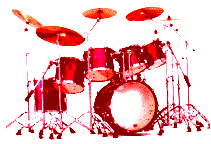 School of Drums
School of Drums
The 16th-Note Disco Beat: It meant that almost overnight, bands everywhere were replaced by DJ's. The advent
of better amplifiers and higher quality speaker-systems created a situation where recorded sound became as pure as 'live' sound.
One person could replace of 4 or 5 people on stage, thus saving the night club owners a small fortune, while entertaining
the crowds just as efficiently. In a sense, the dancers became the focus of interest and the music (or musicians) were
no longer the prime focal point. It created a depression of sorts for working musicians who depended on the night clubs for their bread
and butter. In many minds, the beat name "Disco" doesn't do this interesting beat-pattern justice. The truth is, this fascinating beat-pattern existed
before the so-called 1970's Disco era and it has survived it. This form of 16th 4/4 is still very popular
today and it should be for many years to come. Every drummer worth their salt will be wise to become fluent with it. As a quick 'nutshell' description, this pattern is really just a 16th 4/4 rock beat, but the
16th notes on the hi-hat are played with both hands as a single stroke roll. Playing it this way allows us to double our speeds and tempos
with 16th 4/4 which tends to push it into the same tempo zone with 8th rock 4/4. It is common for drummers to switch back and forth
between 16th Disco and 8th 4/4 in mid song as a way to add rhythmic variety (excitement) to virtually any 8th-note 4/4 song. Technically,
any 8th-note 4/4 song can easily be converted to 16th 4/4 by mixing the two beats. I will lay it out very simply here in graduated steps, but make no mistake . . . it
is easy to quickly get complex with this one. The more we experiment with this beat structure
the more variation (permutation) possibilities we discover. It is akin to 8th rock in the sense that
all of our bass variations and syncs will be almost the same. In other
words the more comfortable we are with 8th rock bass-variations and bass-syncs,
the more fun we can have with 16th Disco and the more exciting we can make it. SIMPLE DISCO: Also try
placing a bass drum along with the first of every 4 hi-hat notes. In other words,
play quarter (4th) notes on the bass. There were many popular
Disco songs during the 1970s using that (4th note bass drum) form of the beat pattern, exclusively. (It's very
boring, but also very easy.)
BASIC DISCO: I have written these patterns in 2/4 time for simplicity. 16th Disco is
normally written in 4/4. As you see below, when written in 4/4 time
the pattern looks more complex but it is really just two repetitions
of the same thing. There's more! Try playing occasional open hi-hat notes too. Just lift the hi-hat
pedal and strike the top cymbal while it is in the up position . . . then close it
on the next count. AND MORE . . . Video: For almost all handheld devices and other browsers.
Musical Time - Finite to Infinity: Finite to Infinity: Discover the (lost) 500 year-old enigmatic secrets hidden within
the current time-signature system. Seven short mesmerizing and easy-to-follow lessons will lead you quickly and easily towards
(musical-time) guru status. You will learn to visualize (read, write or feel) the existence This should lead
directly to the e-book. This very informative little booklet will amaze you
with hundreds of valuable tips and insider secrets! HOW TO: Purchase old/used drumsets for pennies and resell them for decent
profits.
![]()
![]() Song Beat: "DISCO" or Overhand 16th 4/4'
Song Beat: "DISCO" or Overhand 16th 4/4'
![]()
![]()
This beat might best be called '0verhand
16th 4/4'. It got stuck with the undeserved 'Disco' handle back in the 70s. Many working musicians despised the 'Disco Era' of pop music because
it created a shortage of jobs for pro-musicians.
This first beat (below) is probably the simplest form of Disco. You will be
playing a single-stroke roll on top of a closed hi-hat and placing a bass note
along with the first of every eight notes. Repeat this pattern until you can play it at
lightning speeds. Not only are you mastering the Disco beat but this is a great
exercise for helping students develop lightning speed with 16th singles. 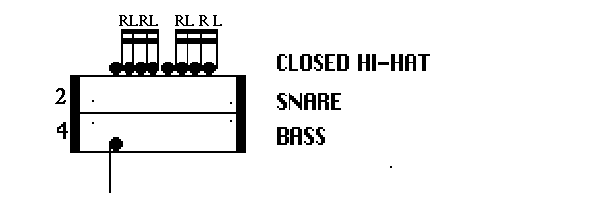
![]() Listen to it.
Listen closely to the cymbal rhythm. It may be difficult to hear it.
Listen to it.
Listen closely to the cymbal rhythm. It may be difficult to hear it.
The next trick is to maintain the same steady roll as above but simply come off the hi-hat,
play a snare on the backbeat (in place of the 5th cymbal note) then return to the hi-hat
again by the next right hand note. It is really the exact same thing as the Simple Disco Beat above
but we will make a quick detour to the snare on every 5th (hi-hat) cymbal note.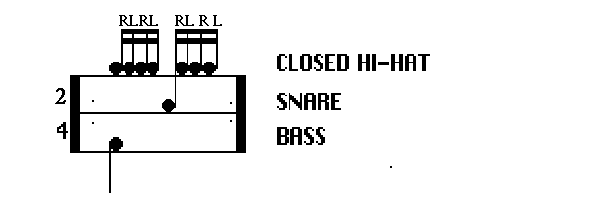
![]() Now listen to the BASIC DISCO beat. Pick out the
snare note. This is a right-hand note (for all but the left-handed students). Simply move off the hi-hat for just that one note in each repetition.
Hit the snare once then move back to the hi-hat. If you are playing on simulated drums . . . use your imagination and two objects. (Use one
object as a hi-hat and another as a snare drum.)
STANDARD OR CLASSIC DISCO:
Now listen to the BASIC DISCO beat. Pick out the
snare note. This is a right-hand note (for all but the left-handed students). Simply move off the hi-hat for just that one note in each repetition.
Hit the snare once then move back to the hi-hat. If you are playing on simulated drums . . . use your imagination and two objects. (Use one
object as a hi-hat and another as a snare drum.)
STANDARD OR CLASSIC DISCO:
This is essentially the same beat, but now we are placing an additional
bass drum along with the backbeat. This form of Disco is very common
but also very limited. The bass is so busy that there isn't much room to do much of anything
else with it. While you may need this form of the beat occasionally, the basic
form (above) is much more flexible. When playing the basic form, you
will discover that injecting bass variations and syncopations will come natural.
As I said earlier, all of your routine 8th rock variation ideas (like fatback
and others) will come easy and natural when focusing on the basic form of the
beat pattern. At any rate it will be wise to develop confidence with both forms.
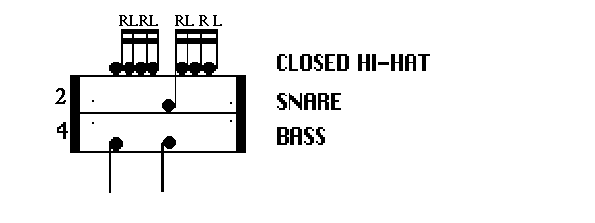
![]() Standard or Classic Disco (above): Listen for that extra
bass drum.
Standard or Classic Disco (above): Listen for that extra
bass drum.
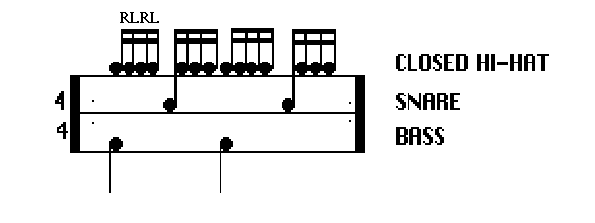 After gaining confidence and speed with the basic disco pattern, try
playing the fatback bass patterns we studied in the rock variations
lesson.
After gaining confidence and speed with the basic disco pattern, try
playing the fatback bass patterns we studied in the rock variations
lesson.
![]() Disco Fatback might
sound something like this, but you can do almost anything you wish with
the bass. There are something like 65,536 possible variations with
just the bass drum within this song-beat framework.
Disco Fatback might
sound something like this, but you can do almost anything you wish with
the bass. There are something like 65,536 possible variations with
just the bass drum within this song-beat framework.
![]() Standard or Classic Disco with Open 'And" Hi-hat Notes (above).
Standard or Classic Disco with Open 'And" Hi-hat Notes (above).
In addition to all of the above, try switching from 16th Disco to 8th rock
and back without losing tempo. The beat tempo will remain the same but as you
return to 8th rock, the number of cymbal notes will be cut in half. Also the
left hand will return to its normal position on the snare.![]() VIDEO: Click here to 'Play', see, and hear everything in this entire lesson, at a moderate tempo. This
video is designed for Internet Explorer using Windows Media Player.
VIDEO: Click here to 'Play', see, and hear everything in this entire lesson, at a moderate tempo. This
video is designed for Internet Explorer using Windows Media Player.
![]() Copyright Bill Powelson 1996-2008-2014 @ all rights reserved.
Copyright Bill Powelson 1996-2008-2014 @ all rights reserved.![]()
![]()
Cool Drum Solos.
Video Drum Solo Lessons Free

Drum Solo Video: Click to 'LEARN' Watch and Learn Now! PLAY Great Drum Solos within hours (not years).
NEW 'Subliminal Method' teaches drum solo techniques PAINLESSLY!
Master rudiments 'NATURALLY' without boring regimentation or serious discipline.
Listen, watch and PLAY your way to awesome drum solos (and polished rudiments) BY SIMPLY HAVING FUN. . . . It works, folks!
Don't be a skeptic until you at least try it first. You owe it to yourself toTRY IT RIGHT NOW!
![]()
![]()
Membership Includes
EVERYTHING FREE! All the E-book icons are "hot" here at the password site. Click an e-book icon and go directly to the product.
Bill Powelson's Other Drumming Courses
![]()
